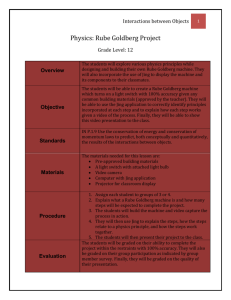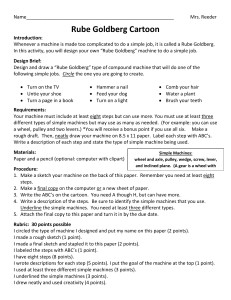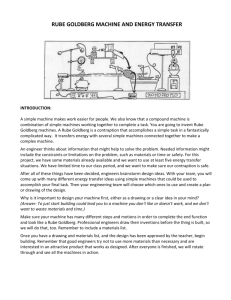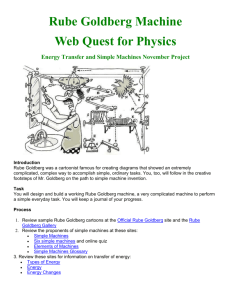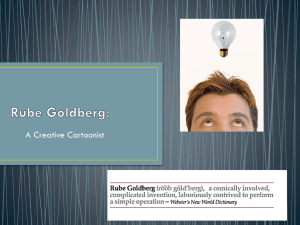Rube Goldberg Device Project Guide: Simple Machines
advertisement
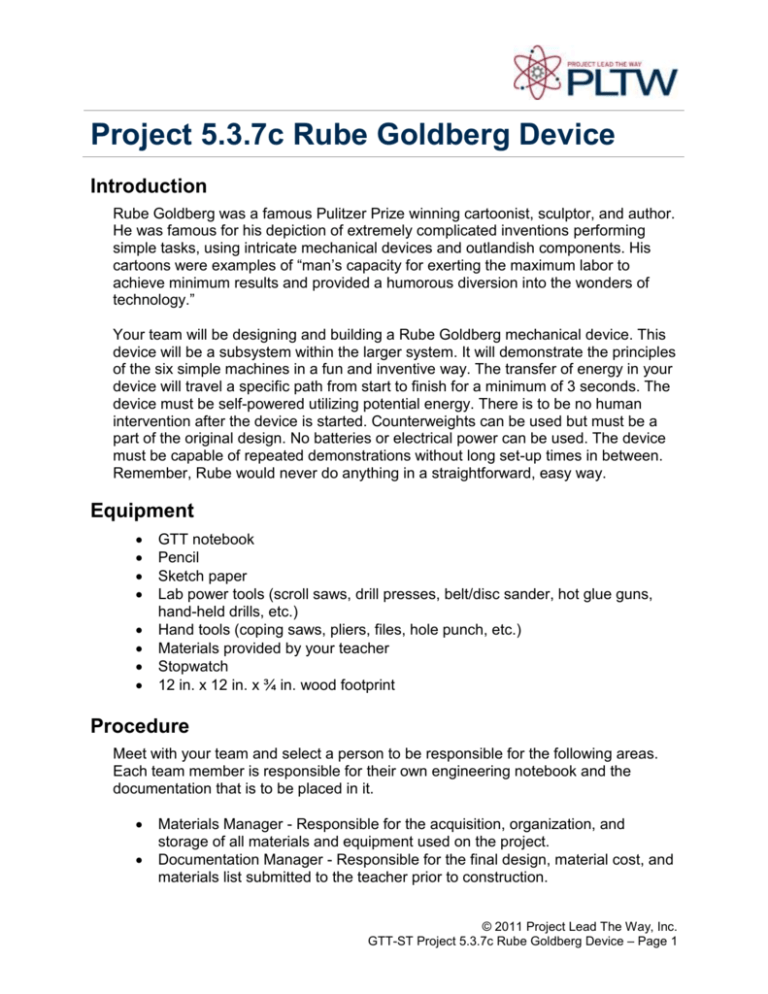
Project 5.3.7c Rube Goldberg Device Introduction Rube Goldberg was a famous Pulitzer Prize winning cartoonist, sculptor, and author. He was famous for his depiction of extremely complicated inventions performing simple tasks, using intricate mechanical devices and outlandish components. His cartoons were examples of “man’s capacity for exerting the maximum labor to achieve minimum results and provided a humorous diversion into the wonders of technology.” Your team will be designing and building a Rube Goldberg mechanical device. This device will be a subsystem within the larger system. It will demonstrate the principles of the six simple machines in a fun and inventive way. The transfer of energy in your device will travel a specific path from start to finish for a minimum of 3 seconds. The device must be self-powered utilizing potential energy. There is to be no human intervention after the device is started. Counterweights can be used but must be a part of the original design. No batteries or electrical power can be used. The device must be capable of repeated demonstrations without long set-up times in between. Remember, Rube would never do anything in a straightforward, easy way. Equipment GTT notebook Pencil Sketch paper Lab power tools (scroll saws, drill presses, belt/disc sander, hot glue guns, hand-held drills, etc.) Hand tools (coping saws, pliers, files, hole punch, etc.) Materials provided by your teacher Stopwatch 12 in. x 12 in. x ¾ in. wood footprint Procedure Meet with your team and select a person to be responsible for the following areas. Each team member is responsible for their own engineering notebook and the documentation that is to be placed in it. Materials Manager - Responsible for the acquisition, organization, and storage of all materials and equipment used on the project. Documentation Manager - Responsible for the final design, material cost, and materials list submitted to the teacher prior to construction. © 2011 Project Lead The Way, Inc. GTT-ST Project 5.3.7c Rube Goldberg Device – Page 1 Communications Manager - Responsible for the communication between your team, the teacher, and the teams directly before and after yours. 1. Begin brainstorming possible solutions for your grid block. In your engineering notebook, each team member must restate the problem in their own words and sketch two possible solutions. Label the simple machines being used. Don’t forget to consider the requirements and limitations listed below. 2. With your team, reach a consensus on the best solution from the available sketched options. Don’t forget to collaborate with the teams before and after yours. List the construction methods that will be used to build your team’s device and the materials needed. Remember, you may bring in supplies from home with prior teacher approval. 3. After your teacher has given the instruction on tool usage and materials, you may begin to build your team’s device. 4. Troubleshoot the device after it is completed. Evaluate your device using the grading rubric. Changes and adjustments must be made before the final run. 5. Place your grid in its place and conduct the final run. If your teacher chooses to have you work within a budget, keep that in mind when creating your final design. Requirements and Limitations: Your team must meet the criteria stated in the Rube Goldberg Grading Rubric. Be sure to carefully review this rubric prior to starting this activity. Energy should take at least 3 seconds to travel through your machine. (The longer the model operates the better.). Hint: Make gravity your friend. Model height is unlimited, but model must stay within the 12 in. x 12 in. footprint for length and width. All subsystems should pass the energy at 3 in. above the board and centered or 6 in. from the side. Therefore, all subsystems will also receive the energy at 3 in. above the board (not the floor) and 6 in. from the side. You may use available materials found in the lab. You may also bring materials from home. Remember: Use your creativity, problem-solving ability, and the skills you have learned in class to make the best design possible. © 2011 Project Lead The Way, Inc. GTT-ST Project 5.3.7c Rube Goldberg Device – Page 2 Costs of Goods and Equipment Chart Tools Amt ($) Hammer Pliers $1 $1 Snips Wire cutters Hand saws $1 $1 $5 or $1 per cut $10 or $2 per cut $1 Power saws Files Paper cutter Scissors Glue gun Staples Xacto knife Drill press Sander Scroll saw Band saw $5 or $1 per cut $1 Free $1 $1 $5 or $1 per hole $5 $5 $10 Materials Amt ($) $1 / 6 in. $1 ea. Consult fee Straws Amt ($) $1 / min $1 / 3 $1 $1 / ft $5 / ft Pulley Wood glue Marbles $20 ea Free $2 ea Paper $1 / sheet Rubber band $1 Lg. cardboard Spoon $2 ea ¼ x ¼ wood $25 / sheet $1 ½ x ½ wood ½ x 2 wood ¼ x ½ wood Nails Dixie cup $3 $10 $2 $1 for 2 $2 Mouse trap Vehicle Markers $20 $20 $1 per color Free All tape Popsicle sticks Clear plastic Wire Tubing Rulers Misc. Conclusion 1. What were the most important criteria your team used to select the final design of your device and why did you use them? 2. What changes would you make if you could redesign your Rube Goldberg device? © 2011 Project Lead The Way, Inc. GTT-ST Project 5.3.7c Rube Goldberg Device – Page 3
